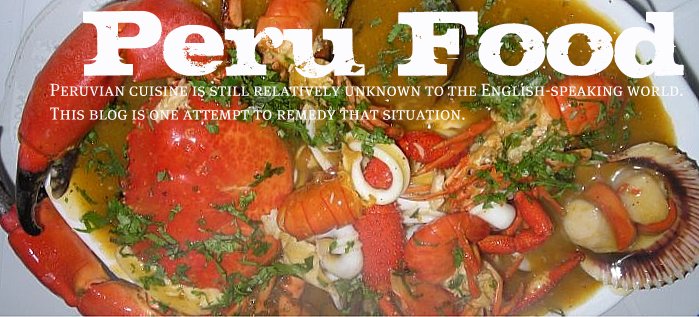 The algarrobo tree
The algarrobo treePhoto: Instituto Nacional de Recursos Naturales
There are many different types of cocktails prepared in Peru.
While the pisco sour is the most famous one, a close second is the coctél de algarrobina, or algarrobina cocktail, a creamy drink similar to a brandy Alexander.
It is one of my favorite after-lunch or after-dinner drinks, akin to a very potent milkshake. But, what is it? And, where does it originate?
The following article by Maricel E. Presilla provides insight, and a recipe, for this unique Peruvian cocktail.

Maricel E. Presilla
Culinary historian Maricel E. Presilla, who specialize in the foods of Latin America and Spain, is the chef and co-owner of the pan-Latin cuisine restaurants Cucharamama and Zafra in Hoboken, New Jersey. In addition, she is the Our Cocina columnist for the Miami Herald.

Holding a doctorate in medieval Spanish history from New York University, she writes extensively about the culinary history of Latin America. In particular, she has conducted considerable research on Latin American agriculture, with special emphasis on tropical crops, such as cacao and vanilla, and chocolate production.
Clearly, a woman with many culinary interests, she is also the president of Gran Cacao Company, a food research and marketing company that specializes in the sale of premium cacao beans from Latin America.
Her latest book is The New Taste of Chocolate: A Cultural and Natural History of Cacao with Recipes.

Dr. Presilla has very kindly allowed me to republish an article she wrote about the algarrobo, the essential ingredient for this unique Peruvian cocktail, which was originally published in the Miami Herald.
Algarrobo's Gifts: Shade, Syrup, And Smoke by Maricel E. Presilla, originally published in the Miami Herald
On a noontime walk last spring not far from the town of San Pedro de Lloc in northern Peru, I found refuge from the sweltering sun in an algarrobo grove. In this desolate landscape where the wind sweeps the coastal sand against rocky hills to form gigantic dunes, these lovely trees provide the only splashes of green.
A New World native, the coastal Peruvian algarrobo (Prosopis pallida) is similar in shape to the acacia and prospers in many arid regions of Latin America. I picked a couple of its long, yellowish pods and had a taste of the sticky pulp that covered the hard beans within. They were pleasantly sweet with the subtle, tangy bitterness I have come to appreciate in algarrobina syrup.
A trademark of northern Peru, this sweet, aromatic syrup the color of tar and the consistency of molasses has a touch of bitterness and acidity and a beany quality that reminds me of hoisin sauce. Used in cocktails and desserts, it is an assertive ingredient, and its distinctive flavor lingers in your mouth.
I first tasted it in a Peruvian pisco cocktail (cóctel de algarrobina) that is cross between a milk punch and a brandy Alexander. In typical Latin fashion, it mixes condensed and evaporated milks, eggs and algarrobina syrup (known in Spanish as jarabe de algarrobina). The syrup lends backbone that cuts though the sweetness and blends seamlessly with the pisco. I fell in love with this ingredient, and began developing algarrobina flans, puddings and ice creams for my restaurant Cucharamama.
The algarrobina sold in U.S. Latin markets has an English label that incorrectly describes it as carob syrup. (They share some similarities, but carob is the pod of an Old World plant.)


Today, in parts of Peru like Piura, which is close to the Ecuadorean border, algarrobo is a regional industry. The pods, produced twice a year, are harvested when they fall to the ground, boiled in water and pressed, and the resulting liquid is strained and then condensed through evaporation to make syrup. In another process, the pods are dried and ground into a flour that is used for desserts (harina de algarrobina) or toasted to make a substitute for coffee.
A relative of the North American mesquite, the Peruvian algarrobo makes excellent charcoal, and in rural regions where most people depend on wood or charcoal for cooking, algarrobo groves are being cut down for fuel, contributing to soil erosion and habitat destruction.
I heard the sound of trees being cut down while I rested in that grove. A Peruvian friend who is a conservationist predicts that despite of strict government regulation, the indiscriminate lumbering of the algarrobo will continue.
I felt a profound sadness, for solutions are not simple in this case. The algarrobo is a useful plants that protects the environment, providing food and shelter for people and animals in a land where wind erosion extracts a heavy toll. But the traditional cooking of this part of Peru also owes part of its terrific flavor to the aroma of the algarrobo wood and charcoal. Without it, the food will no longer taste the same.
Perhaps, the solution is in conservation and propagation, in reaching a balance that will allow cooks to enjoy the algarrobo in all its goodness.
Recipe: Algarrobina Cocktail
The traditional version of this Peruvian cocktail calls for egg yolks, but I find that the syrup and milk add enough creaminess.
2 ounces pisco quebranta
1 ounce (2 tablespoons) algarrobina (sold as carob syrup in Latin markets)
1 ounce (2 tablespoons) condensed milk
2 ounces ( 1/4 cup) evaporated milk
4 or 5 ice cubes
Ground cinnamon
Place all the ingredient in a blender and mix at high speed until frothy. Sprinkle with cinnamon and serve in an old-fashioned glass. Makes 1 serving.
Article and recipe: Maricel E. Presilla
Peru.Food@gmail.com
.
.
.
Click here for the Peru Food main page.
TAGS: Peru, Peruvian, food, cooking, cuisine, cocina, comida, gastronomía, peruana
TAGS: Peru, Peruvian, food, cooking, cuisine, cocina, comida, gastronomía, peruana




2 comments:
I find your site very intersting. I am lucky enough to live in Chicago and we have two wonderful Peruvian restaurants. I look forward to reading more of your posts. Great photographs.
Thanks Salvatore!
Post a Comment